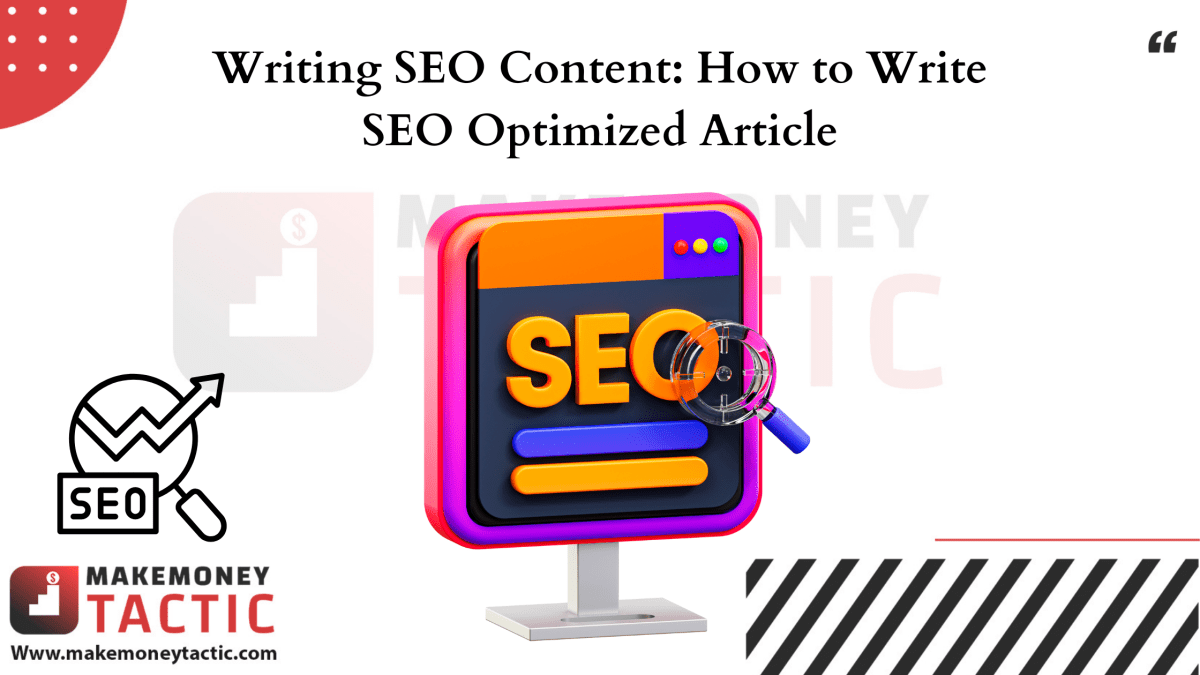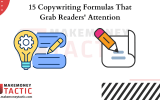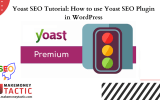Indeed many of you will wonder why there is very quality content but still not ranking well. The reason may be that the user experience has not been optimized and is not friendly to readers and search engines. Here comes the importance of SEO based content writing. You should learn how to write SEO optimized article.
How to write SEO optimized article in 2 parts with 5 steps?
Part 1: Create the Best Article on the Topic Written, covering the steps from brainstorming on the topic, and identifying the unique and valuable points, to researching the topic. The steps in part 1 include:
- Step 1: Research the topic/keyword for the article
- Step 2: Create an outline for the article
Part 2: Optimizing Articles for SEO – apply recommended optimization techniques in line with Google’s quality guidelines. Part 2 includes the following steps:
- Step 3: Optimize SEO standard articles
- Step 4: Checklist to check if the article is SEO ready
- Step 5: Publish and promote the article
How to write SEO optimized article: Why?aida

SEO Content Optimization: Optimizing Content with search engines is one of the top essential factors when search engines scan your website, determining the relevancy between content and keyword phrases.
If you combine Content and SEO properly with website optimization techniques, your page will have a good chance of being ranked high on the first page in search.
Benefits of writing optimized SEO content:
- Identify the essential keywords of the article that users use to search on Google.
- The article is more optimized in terms of semantics. The topic is explored more deeply and broadly. A reasonable keyword allocation makes it easier for Google to understand the content and have a higher chance of ranking.
- The relevance between content and keywords is rated higher in quality score.
- Using Google Adwords advertising will increase the quality score, help reduce bids and save businesses costs.
- Practice better writing skills every day.
- Increase traffic to the website, bring in more potential customers from the search channel and increase revenue and sales efficiency.
- Standard SEO content can also help you make money from a Blog.
✅See also: How Much Should a Blog Post Length Be?
How to write SEO optimized article: Factors to ensure standard SEO content articles
Before you write standard SEO content, keep the following 2 points in mind:
- First and foremost, you should write content naturally written for readers, then optimize for Google. You need to create quality content that provides practical value to help your readers find answers and assist them in solving problems.
- Besides, you must not abuse excessive SEO optimization techniques, spam keywords, or fool Google to rank up. You will not get good results if you abuse too many SEO techniques.
A standard SEO content article must ensure the following factors:
- Value: The article carries valuable information that is useful and meets the purpose of the reader.
- Uniqueness: Bringing out a new point, a unique angle on the topic.
- Catch-Title: Have a catchy title for the article.
- Attractive intro: Provide helpful information at the beginning of the article to make readers want to continue reading the article.
- Paragraph: Divided into short paragraphs of no more than 4 lines.
- Headings: Use sub-headings to structure the article.
- Use keywords and main keyword phrases in the first paragraph.
- The recommended keyword density is 0.5 – 1.5%, distributing keywords naturally throughout the article.
- Main keywords and essential keyword phrases in Title (H1) and subheadings (H2, H3,…)
- Highlight essential content that contains keywords or key phrases by bolding or italicizing.
- Write with correct grammar and no spelling mistakes.
- In the last sentence, there should also be keywords to emphasize the keywords more.
✅See also: How to Structure a Blog Post in 12 Steps?
How to write SEO optimized article in 5 Steps?
Here is a detailed guide on how to write SEO optimized article:
Step 1: Research Topics/Keywords for the article
1- Identify Topic Ideas for the article (Ideas)
You need to identify the main topic and then research the topic to exploit and expand the scope of the topic. The research step will help you get more ideas to develop the article.
Research the topic carefully before writing: When you research a topic, you put yourself in the shoes of the reader who wants to dig deeper into the topic. Find out what problems they face, what questions they are looking for answers to, etc. You need to consider and consider the above issues to appear in your article.
Notes when researching the topic:
- Identify reliable sources and high-ranked articles for research.
- Read for reference 3-5 articles at the top of Google Search on the topic you will write about. Refer to the good points the topic has covered and create better content than the content ranking.
- Read more articles from foreign sources on the same topic (if necessary).
- Outline your article – build a hierarchy with subheadings by gathering from competing sources on the same topic.
- Prepare images and videos corresponding to the topic and subsections in the article.
Define goals to write content and target the right keywords: You must know which keywords users will use to find information about the topic you are writing and what they want to receive. Here are a few ways you can define goals:
- Understand the purpose of the target audience (Audience): The article content is for specific groups of people, and you need to understand the search intent (User Intent) to create the most appropriate content. Only then will your article attract, meet the requirements of readers, and achieve business goals.
- Topic Cluster Targeting: Topic cluster targeting allows you to reach the important points of the topic at a deeper and broader scope.
- Understand Search Intent Behind Searched Keywords (Keyword Intent): Choose a suitable word or phrase related to the article’s topic with high searches.
✅See also: Best 15 Free Keyword Research Tools for SEO: Rank on Top of Google
2- Research understanding user intent on the topic you will be writing about
You need to understand the needs and goals of your readers to create appropriate content that meets the needs of your readers. Help readers get answers and solutions to problems.
You need to answer the following questions to find the reader’s intent when approaching the problem:
- Who is the searcher, and what are the reader’s most significant challenges and goals?
- Why are readers looking for this? What questions is the reader trying to answer?
- What values do they really want to receive?
- What information would you provide if we knew who the reader was and what they were looking for?
- How will what is offered in your article differ from what readers find elsewhere?
✅See also: What is The Importance of Market Research
3- Keyword research to identify potential keywords, expand the idea of the topic
Keyword research and selection are essential in SEO to develop content writing ideas for your topic. You can research potential keywords using keyword research tools like Google Keyword Planner or Ahrefs.

Through keyword research, you will choose the target keyword (Target Keyword) that users search for on search engines. From there, you will determine the most appropriate keywords for the article.
The final purpose of the keyword research and analysis step is to develop a list of potential keyword phrases on the topic you write to use and allocate keywords appropriately in the article. So, after determining the right keyword list, you need to identify the article’s main and auxiliary keyword phrases.
✅See also: How to Use Semrush for SEO: Get Traffic with Semrush
4- Research the competition from the top articles on Google
How do you make your article stand out from competitors writing on the same topic on the Google search results page? To do this, you need to find solutions to the following problems:
- Does your article include the most important points of the top-ranking articles on Google?
- Does your content add value, useful information, and uniqueness that other places don’t?
- Does your article help readers find answers or help them solve problems?
- Do your articles give users a great experience on all devices?
After researching and collecting data on the topic, you need to choose the following:
- Useful information from top-ranked competitor articles.
- Collect headings and sub-headings in top-ranking articles.
- Collect valuable pieces of content (consider rewriting source copy, and use them as citations and cues to develop your writing ideas).
The next step you need to create an outline for the article.
Step 2: Create a sketch for the article (SEO standard content structure)
A detailed outline can significantly reduce your writing time. You will be able to maintain consistency throughout the writing process. Your core argument will stay intact, and you won’t get lost halfway through your post.
Create an Outline for your article with 8 easy steps:
- Identify the bottom line for your readers.
- Create clever headlines to capture attention.
- Brain Dump: Write down every question you need to answer.
- Arrange the main themes and parts of the sketch.
- Ask more questions.
- Insert relevant information, data, and additional sources.
- Briefly edit the outline.
- Reply.
Tips for creating an outline
Here are tips for creating an outline for your article:
- Write down the title and state the central question or idea you are trying to answer or explain.
- Write down your target audience and the ultimate goal of the post.
- Create questions around the focus topic to capture the attention of your target audience.
- Write down how you will lead to your arguments/arguments/solutions.
- State your point and break it down into smaller sub-points.
- Go through each sub-point, find out how much you already know about the sub-points and what’s left to learn.
- Based on that, frame the research question and start doing the research.
- Use Workflow to create an outline. Workflow is a useful tool to help you manage your research and ideas.
- Put yourself in the position of the target audience to see if any questions are left unanswered in the article.
- Does the article provide enough visual examples or wording to make it easy for readers to understand and implement its proposed solutions?
- Does the article provide enough information or cited data to support any of the items?
- Have you typed the headings in the correct order? Is it missing or out of place?
- Are the content sections properly distributed? Is there any irrelevant or inappropriate content?
Use the Inverted Pyramid model to create an SEO-standard article structure
The Inverted Pyramid model attracts readers quickly. Accordingly, the importance of content decreases through the following sections:

- The first part: Introduce, lead, ask questions and evoke the topic enough to make readers decide to continue reading the lower part of the article. The first part carries the most important information. It is necessary to follow the 5W1H technique.
- Body: Presents the details of the content. You must write the important content first, then elaborate further in the following paragraphs. Body writing techniques include: creating an argument, telling a story, raising a problem, giving evidence, etc. Use images, videos, etc., to make the article more vivid and support the transmission of information on the topic.
- Last part: Summary. Less information is provided, with more relevant articles and specific calls to action.
Important points when presenting articles according to the Inverted Pyramid model:
- Order the items in descending order of importance.
- Push the important points to the top of the article.
- Push the most important points of paragraph groups to 1 Headline.
- Push the most important point of the paragraph onto the first sentence of the paragraph.
- Limit each paragraph to one point or one main idea.
See more about How to Write Good Content in 5 Steps? Improve Your Writing Skills to increase search engine rankings.
Step 3: Optimize SEO-Friendly Content
While writing content, you pay attention to applying some of the following SEO criteria in the article:
- Write naturally, do not repeat a keyword more than 15 times.
- The main keyword should appear once in the first part of the article, twice in the middle paragraph, and once at the end.
- The main keyword must appear in the <TITLE> tag and the Meta Description.
- The Meta Description tag must contain both the main keyword and the secondary keywords that modify the main keyword but still be search-friendly.
- The article title is always in the H1 tag.
- The main keywords should appear in the heading tags (H2, H3, …) and bold when necessary, avoiding italics and underlining. Note: Avoid bolding a keyword more than once.
- Internal Linking should lead to other articles with appropriate anchor text.
To implement SEO Content effectively, your editing tool must have full functions to support content compilation and include SEO criteria in the article.
Here are the 10 most important criteria for your article to be considered an SEO standard article:
1- Set an attractive title – increase click-through rate (Title)
An attractive title is the most important thing when optimizing SEO for articles because the title affects the reader’s click decision to want to read your article or not.
Captivating headlines can include 1 of the following elements:
- Start with a promise: point out the benefits the reader will get from reading the article.
- Touch emotions: add interesting verbs or adjectives.
- Stimulating curiosity and attraction: start with a question.
- Impact on the reader’s thoughts: State a controversial opinion.
- It should show the most crucial point of the content.
Here are some examples of headlines that grab the reader’s attention:
- The title has 1 promise
For example, 3 little known reasons why your blog isn’t being visited (and here’s how to improve it)
- Put numbers in the article
For example, 5 tips to bring keywords to the top of Google in 10 days.
- Time and money
Example: Lose 5 pounds in 2 weeks with only 500K
- Question 5W1H
Example: Are you having problems with…
- Tips, secrets
SEO secret to top quickly and sustainably
- Promotion
Example: On the occasion of Christmas, 50% off all products
- My story
Example: How I got my Google Digital Marketing Certification in just 2 weeks
- Age limit
Example: Movie xxx is only for 18+
2- Optimize the opening paragraph of the article (for the meta description tag)
A compelling quote invites the reader in, promises their time will be well spent, and gives an overview of the article’s content.

Here are some tips for writing meta descriptions:
- Includes 1 Hook answering the question of why readers click on the article.
- Clear and concise, in 25-40 words.
- Focus on the most important point with the 5W1H technique.
- Summarize and condense key facts in 10 words.
3- Optimize for images in articles
The image must be closely related to the content of the article. The image name and ALT attribute should include the main keyword of the article that users use to search.
Image name: Before uploading an image to your website, make sure you rename the URL to be Google-friendly. The image name should include the main keyword, separated by a hyphen (-) and written without accents.
For example, in an article about SEO trends 2022, the keyword is SEO trend 2022. The image name should include the following keyword: SEO-trend-2022.jpg.
Alt tags of images:
- Search engines will read image content based on Alt tags.
- Describe information close to the image.
- Contain keywords.
For example: <img src=”SEO-trend-2022.jpg ” alt=”SEO trend 2022″ />
Size (size) of the image: Depending on the content and field of the article, you should leave the corresponding image size. The average image size is usually <100 Kb.
The caption of the photo: This is the caption for the photo written right below the photo. Photo captions are shown in Vietnamese with accents, separated by spaces, and italicized.
4- Use Headings to improve article content structure.
Heading helps readers know the content of the paragraphs in the header. A useful way to optimize title tags is to compare title tags with a book’s table of contents:
- H1 introduces the topic your article is about, just like the title of a book tells the reader all the book’s content.
- H2s are similar to book chapters, describing the main topics you will cover in sections of the article.
- Headings H3 through H6 are additional subheadings in each section, much like a book chapter can be divided into several subtopics.
✅See also: IMAGE SEO: How To Optimize Images For SEO and Rank Higher?
5- Allocate keywords appropriately in Articles
Some tips for in-article keyword allocation:
- Choose 1 main keyword (target keyword).
- Choose about 3-5 secondary keywords that complement the main keyword.
- The main keyword appears in the tags: Title, Description, H1, and the content appears about 5 times right in the introduction at the beginning, the middle, and the article summary.
- Secondary keywords appear in H2, and H3 tags, in bold italics.
Example of distribution of primary and secondary keywords in the image below with the Main Keyword: Chocolate Donuts

6- Internal Links to Related Articles
Internal Links link from one page to another within the same website. Internal linking is also used to connect one article to another, but it must still be in the same domain.
When used properly, internal linking forms a link structure in the website that can be easily redirected from one page to another. Internal linking helps increase the time On-Site on the website and is also a factor for ranking on Google.
However, you should use internal links reasonably, avoiding overlapping many offensive and annoying links for users.
✅See also: On-page SEO Techniques: How to Increase Website Traffic?
7- Lead external links to reputable sites that create trust with Google
The skillful use of Outbound links helps increase the article’s trust with the Search Engines. In addition, Outbound links give readers more experience and information; the article gets high rankings in Search Engines.
Outbound links do not eliminate the positive effects that inbound links bring to the website. However, you should use outbound links reasonably, not too much, and don’t forget to use rel=”nofollow” in the <a> tag.
✅See also: What Are Backlinks? How to Increase Backlinks for Free? +10 Techniques
8- Highlight important information when skimming
Readers always want to immediately see the most important information in a clear, concise, and attractive way when scrolling through your articles. Readers will leave immediately if they encounter documents not presented “Clean & Clear.”
Therefore, you need to highlight the important information areas of the article with the following tips:
- Use Sub-Headings to structure the article.
- Keep paragraphs short, 3-4 lines, no more than 5 lines.
- Use image captions that contain keywords.
- Highlighting by bolding the important passages of text is the answer to the problem of the article that readers are looking for.
- Use links that contain exact keyword phrases or partial matches (of the linked page) in the anchor text.
- Use the Bullets list.
- Use numbered lists.
- Use Call To Action at the end of the post.
9- Use video to increase time on site and reduce bounce rate.

If 100 people are interested in your content expressed in text and video, then the read-and-view rate is 20% vs. 80%. That’s why you should consider showing your content via video.
10- Use comments to increase interactivity.
For Sewer: Comment is a factor that helps the article increase user visits and helps the website get more review points from the Google search engine.
For businesses: A successful marketing strategy will generate many interactive comments. Whether comments are praise, satisfaction, or criticism, they affect the next direction of the business.
- Satisfied comments praising products and services will increase the business’s brand and reputation in many others’ eyes. All website development activities of the business are also motivated.
- Unsatisfied comments will help businesses realize the weaknesses of products and services to have a better direction to overcome and improve in the future.
Step 4: Checklist to check SEO standards for Content
The purpose of the Content Checklist is to help you go through each step, so you don’t miss any items. At the same time, a Checklist enables you to save time and improve article efficiency.
You can learn more about the checklist to check SEO standard articles to optimize the article in the best way on search pages.
Step 5: Publish & Promote the article
Once the content has passed the moderation step, checked for grammar errors, optimized for SEO, and ensured the checklist has enough important SEO factors, you can publish the article.
For your article to reach the right target audience, you should share it on relevant social networking sites such as Facebook, Twitter, etc. Other methods to support the spread (Viral) of multi-channel Content include Social media, Email marketing, Blogs, etc.
Viral Content supports fast-ranking keywords.
Viral Content will help your keywords rank faster and increase your site’s traffic. So, you should refer to the following Viral Content creation ideas:
- Create hot news content.
- Create content with controversial personal opinions.
- Create visual content with images, animations, videos, memes, infographics, GIFs, and maps.
- Content interaction feature.
- Create feedback.
- Guide readers to make a movement that is of interest.
✅See also: How to Drive Traffic to Your Website: Learn the 33 Free Methods
Statistics, feedback tracking, improvement adjustments
After posting for a while, it will be time to evaluate the SEO results you achieve. You need to measure and evaluate the effectiveness of your SEO campaign to see if you have reached the destination or not; your SEO campaign is on the right track.
- Check Ranking: Check keyword rankings. The easiest way to check how your website ranks is to type in keywords and see if your website shows up on the top of Google.
- Check Traffic: Use Google Analytics to track the number of visits. Google Analytics is an entirely free tool provided by Google. Google Analytics will help your website calculate the traffic and understand the normal traffic patterns of the website.
- Check Issues bugs: Use Google Webmaster Tools to see the site’s errors. If there is a problem in the SEO campaign, you need to have the plan to optimize the improvement for the next life cycle.
The article is the whole technique of Writing standard SEO articles to be friendly to users and search engines. Makemoneytactic firmly believes that your article content will achieve better results when you apply SEO techniques.




